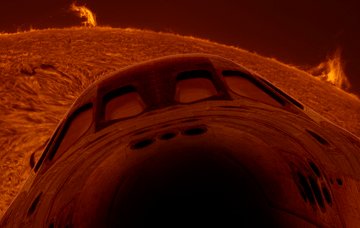 Auroras for Christmas? It could happen... Sign up for Spaceweather PHONE.
Auroras for Christmas? It could happen... Sign up for Spaceweather PHONE.
THE NEXT SOLAR CYCLE: Evidence is mounting that the next solar cycle, due to peak in 2010 or 2011, is going to be a big one. Get the full story from Science@NASA.
HAPPY CHELLEH NIGHT: This morning at 22 minutes past midnight Universal Time, the sun reached its lowest declination of the year: minus 23.5 degrees. Astronomers call this the "winter solstice"--the first day of northern winter and the longest night of the year.
In Iran, "we celebrate the long night (CHELLEH night or YALDA night) by staying up late with family members," says Poyan Shahidi, an Iranian in Toronto, Canada. "We read Hafez poems, listen to Iranian music, eat nuts and fruits, especially pomegranate and watermelon." (continued below)

"In the picture, you can see the table I have set for this special night. I arranged the candles as the winter constellation Orion."
"Happy Chelleh night!"
ROUND AND ROUND "...and round she goes, but where to land? Only NASA knows." Actually, NASA doesn't know where Discovery will land today. It all depends on the weather.
Sitting at his computer this morning, wondering which of three landing sites Discovery will choose, Gary Palmer of Los Angeles created this artistic interpretation of the sizzling re-entry:

The background image was taken by G. Palmer using a Coronado SolarMax90.
Trivia: The surface temperature of the sun is 9000 F. The shuttle's heat of re-entry is "only" 3000 F. So it's not truly as as hot as a G-type star--but still plenty hot.
Check NASA.gov for updates about Discovery's scheduled touchdown this afternoon. To the crew: Safe landing!
Shuttle Galleries: Night Launch and Undocking

